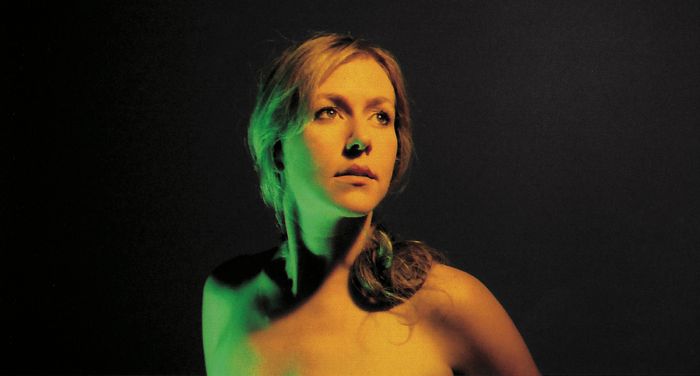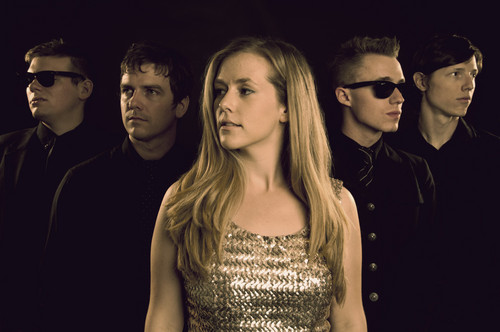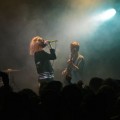Chicago – Greta Morgan Salpeter, better known as Greta Morgan, first made a name for herself as a singer with The Hush Sound. After the band signed with Fueled by Ramen, the Chicagoans moved to L.A. When not soaking up the Cali sun, touring, and scoring films, Morgan taught herself to record and produce her own songs, which would later become the foundation for her solo project Springtime Carnivore. Last fall Springtime Carnivore released an eponymous debut (Autumn Tone Records), which Morgan co-produced with Richard Swift (The Black Keys, Foxygen). Although, it should be noted that Swift only had a hand in three songs; making the psychedelic pop singer’s fabulous debut all the more impressive. Between her stellar debut and “amazingly polished” live performance, Morgan proven that she can go it alone.
Best New Bands caught up with Greta Morgan on a day off from their tour. The humble songstress talked going solo, songwriting, and working with Richard Swift.
You’ve been in and around the music industry for some time in bands like The Hush Sound, Gold Motel, and La Sera. What prompted you to go solo?
Well, you know, it happened pretty naturally. I had started demoing a few of these songs when I was still in other bands. I started recording them myself just as a way to present them to the group. Ultimately, I just had such a strong feeling about the songs and such a strong feeling about the idea that I should create a new project. I was like, “What if this project was just as simple as recording songs by myself?”
Your solo work has gone in a new direction, in terms of sound. There’s a definite retro vibe to your music and even to your music videos, like “Creature Feature.” Is that owed to the music you listened to growing up or is it something else altogether?
I don’t want to be retro in a “kick-back” way. I always want to make music that is very modern, but I’ve just been so rooted in very classic songwriting structures and philosophies, which is that the melody and the lyrics need to be strong. There needs to be a musical skeleton that the production of the song can then be built on. I just love 60s and 70s music, so that definitely comes out in it, but I’m not intentionally trying to be a “throwback” artist, like Duffy. I guess I’m trying to modernize classic songwriting structures and put them in a modern production setting.
Your boyfriend Eddie O’Keefe also has a very old-school vibe to his photography and video work. Has his art influenced yours and vice versa?
Oh yeah, we love working together, and we’re constantly introducing each other to things and coming up with ideas together that will wind up affecting both of our work.
In a recent interview, you said that working with Richard Swift left you with a “sense of self-forgiveness or self- acceptance” that you hadn’t felt as an adult. I assume that filled you with a newfound confidence. How has your boosted confidence impacted your songwriting, producing, and live performance?
Yeah! It’s interesting because I think what Richard did for me emotionally is the same thing a lot of friends and musicians can do for each other, which is to affirm what you’re doing is great. Like, “You don’t need to change a thing. You don’t need to try to be somebody else. Just be you!” I think he’s one of those people who just helped impart that a little bit more in me. It’s definitely made me really excited about making another record with that attitude. Working with him also changed my philosophy of the workflow of recording. My past experience was you just go to the studio for 15 hours a day. You just hammer away. You use all your energy until an album is done. And Richard’s attitude is more of ‘Let’s go to the studio and listen to records for a few hours and let’s draw and make collages.’ Then ‘let’s go for Mexican food, and then when we’re really feeling it, let’s work for like three or four hours.’ He puts more work into setting the mood, and then the recording winds up really great. Where I think in a lot of super sterile recording settings, you spend so long trying to hammer away and get the perfect vocal sound, perfect isolated sound, perfect recording stuff, so a lot of times it takes a while to get the vibe right. I definitely have taken that philosophy that it’s more important to say part of the work is just putting yourself in a really good mindset to create, and then it takes a lot less time to actually end up with the creative output that you want.
Speaking of creating, have you been writing any new material?
Yeah! I was actually just living in Joshua Tree for the month of January. Which is a little desert town about two and a half hours east of L.A. There’s not much distraction there at all. My boyfriend and I were there together. He was writing a new script, and I was writing songs. I had like five or six song-writing ideas I was really excited about. We read and wrote and played rummy and went bowling. (laughs) It was basically like we retired for a month! We had a month-long glimpse into retirement. (laughs)
Okay, let’s talk current material. One of my favorite tracks on your debut album is the instrumental “Karen’s Bird Theme.” I read that as a child you believed that music was a magical way to communicate with animals; you’d ride around on your bike, singing to birds. Is this song related to that?
Oh, thanks! Well, that’s an intelligent journalistic connection you made, but I’ve been working on some music for Eddie’s films. One of the characters is called Karen Bird. I had written some musical themes that would reprise during her key scenes. I wrote four or five themes and that was one that didn’t get used. I liked it, so I put it on the record.
So there’s I think one or two other instrumentals on the album. Is it the same for those?
Yeah, a lot of them are. I wind up writing a lot of instrumentals for film or TV stuff, and if they don’t get used, sometimes I still end up very happy with them as musical pieces.
I feel an eeriness to some of your music. Coming back to your view of music as a child, I know you also thought of music as a means to communicate to the dead. Do you think your early relationship with music contributes to the touch of darkness and sadness in your music? Or do you not feel there’s a sadness to your music?
There definitely is… My mom’s parents died really young. They died in their early 60s. I was probably two or three years old. My mom would play a song on the piano every day. She’d say, “This one is for my mom.” She’d play “Ave Maria.” Then she’d play another classical piece and say, “This one is for my dad.” I always thought that meant they were in the room with us, listening to the music. So I’m not directly playing piano to dead people, but I definitely think music is an energetic form that goes through the world.
That said, there are also signs of hope and happiness, like in “Other Side of the Boundary.” What inspired this song?
That song started with the lyric, “I’m a love song waiting for the dance floor to fill in.” I wrote that when I was thinking about my mom. My mom is single, but she’s one of the most loving people… I was just thinking about whoever is lucky enough to end up with her one day will be so blessed. I was thinking of the idea of someone who has this outpouring of love and is just waiting for the world to receive it or waiting for it to be returned.
That is so beautiful! I also want to talk about “Keep Confessing.” Will you confess to what this song is about?
Once you’re in a really long relationship, whether it’s with a friend or family member or someone you love romantically, you reach a point where you feel you’ve learned all there is to learn about each other, but you have to keep giving. You have to keep finding more. Otherwise, a relationship can start to stagnate… it’s like, “You already know everything about me, but I’m going to keep confessing forever.”
Springtime Carnivore is now on tour with The Dodos. Click HERE for a list of tour dates. Springtime Carnivore is available for purchase on iTunes.
Photos by Eddie O’Keefe
Sarah Hess
After attending The School of the Art Institute in Chicago, Sarah went on to study education at Dominican University, earning a degree in history. When not teaching, writing, or taking in a show, she is most likely to be found with a camera to her eye or hanging out in a darkroom.
You can follow Sarah Hess on twitter at @Sarahhasanh and view her music photography on her website: smhimaging.com.
Latest posts by Sarah Hess (see all)
- The Wild Feathers Check One Off The Bucket List - July 31, 2017
- RY X Captivates Chicago - October 24, 2016
- Four New Bands at Day Three of Riot Fest - September 20, 2016





